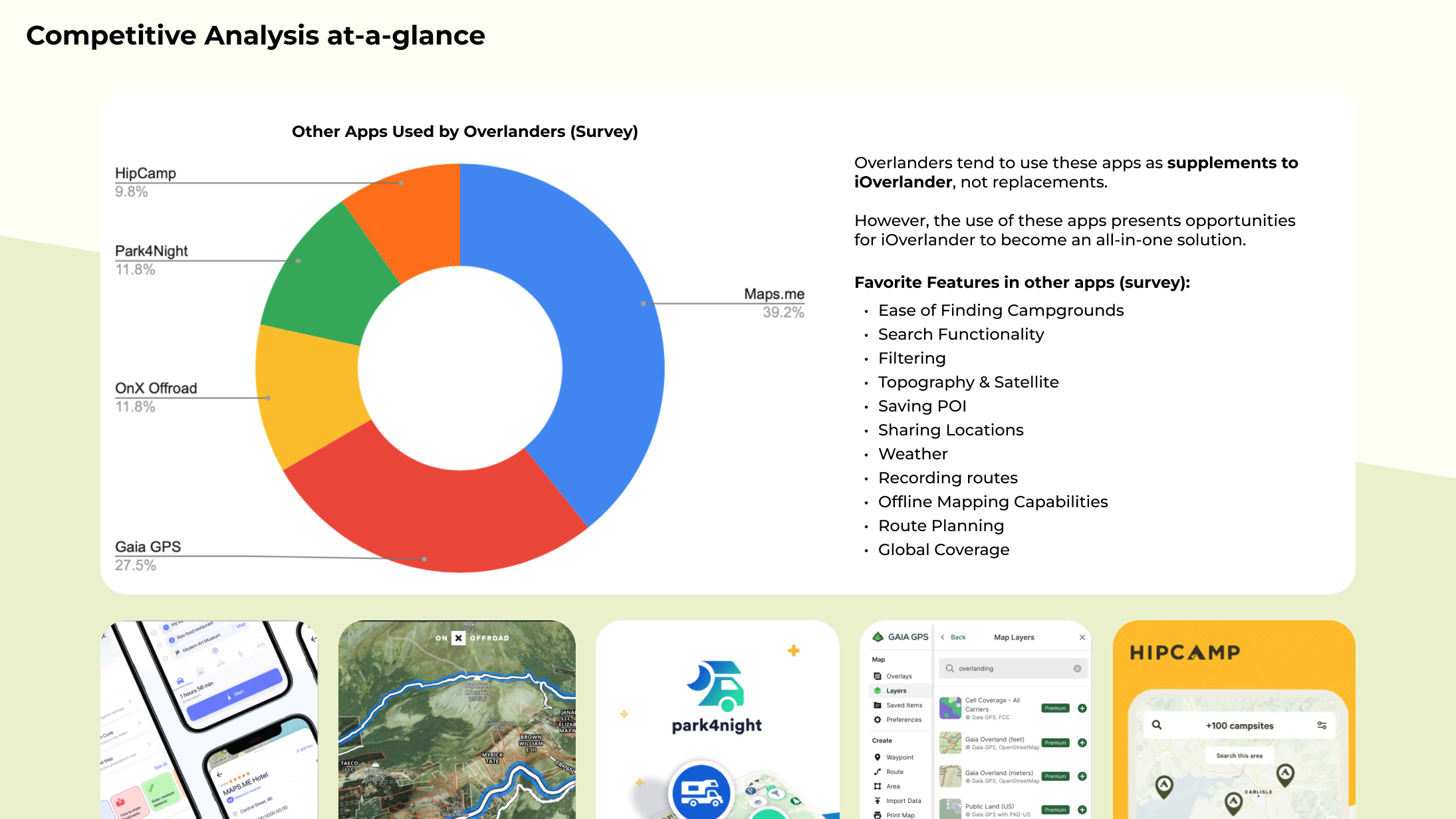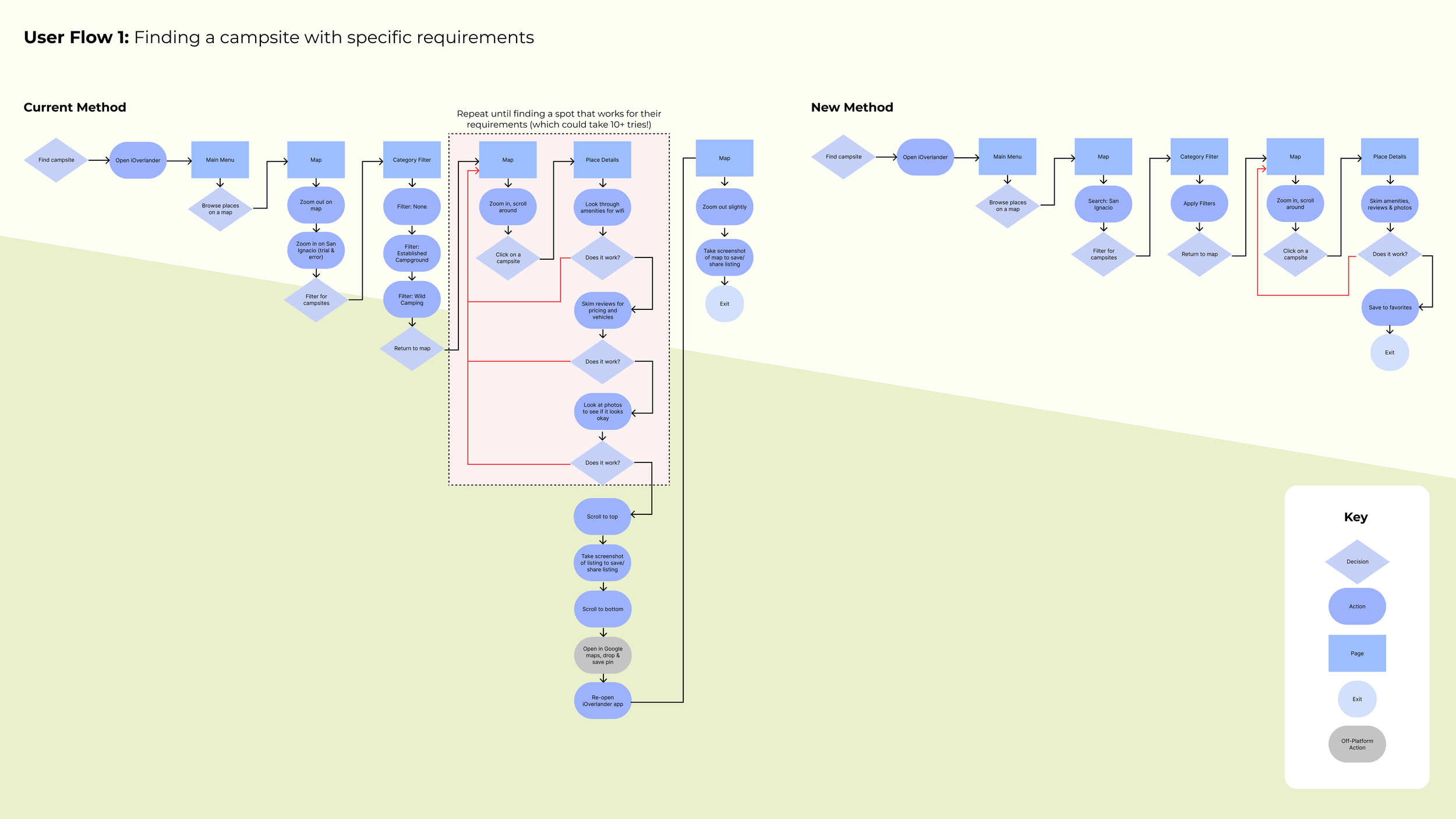
iOverlander
PROJECT TYPE
New App Feature
ROLE
UI/UX Designer
TIME FRAME
2 weeks
SCOPE
Research | Strategy | UI/UX | Prototyping | Usability Testing

-
The Problem
Although iOverlander is an essential app for the overlanding community, it faces usability challenges and lacks critical features, hindering travelers from easily discovering their preferred campsites, saving them for future reference, and seamlessly sharing them with travel companions during their already difficult journeys.
-
The Solution
The site map and navigation were streamlined to enhance the user experience, enabling efficient search functionality and intuitive filtering options for finding campsites. Additionally, the ability to save and share selections facilitates seamless collaboration among travel companions during trip planning.
Key Features
Hover over or click on the green buttons to learn more or click here to open the prototype in a new tab.

Impact
Here is what overlanders had to say about the new features:

-

“Filtering campsites is a time saver! Without filters, we have to click on every single campsite to view which amenities are available, which takes so much time.”
— Jackie
-

“Vehicle hashtags are a helpful solution since we don’t have 4 wheel drive. I appreciate that you addressed the problems I talked about during our interview.”
— Rafael
-

“Being able to save spots while planning has always been an ask of mine. We used to have to take screenshots [to be able to find them again]. This makes it a lot easier”
— Mel
1. Empathize
User interviews | Secondary Research | Competitive Analysis | Surveys | Affinity Mapping | Persona Development
-
Understand overlanders, including user behaviors and pain points within the iOverlander app. Through app reviews, surveys, and user interviews, empathize with users to uncover common frustrations and identify opportunities for improvement.
-
Conducted secondary research by analyzing app reviews to uncover key frustrations.
Collected survey responses from 45+ overlanders worldwide to understand user behavior and pain points.
Conducted user interviews with six daily iOverlander app users to gain qualitative insights.
Performed competitive analysis to understand how other travel apps tackle similar features.
Utilized affinity mapping to uncover patterns and pain points from research findings.
Synthesized learnings in the form of a user persona to inform development.
Created a site map of the current app and identified problem areas based on research.
-
“They identify as campers, they identify as adventure travelers, they identify as off-roaders, they identify as explorers, so really there’s a lot of different ways they see themselves. Overlanding is really a self-sufficient vehicle or adventure mode of travel where it’s all about the journey. At its real core, overlanding is about exploration.”
—Lindsay Hubley, Lodestone Events LLC
-
Overlanders need to more quickly and efficiently find campsites that suit their needs while on-the-go.
Overlanders need to be able to plan ahead due to the nature of living on the road.
Overlanders need to share POIs with friends and significant others in order to plan.
Overlanders want to see only up-to-date and accurate information.
2. Define
POVs & HMWs | Site Map Mark Up | User Flows | Project Goals | Roadmap
-
Define the project's scope and objectives by synthesizing insights gathered from research. Through ideation, analysis, and prioritization, outline a clear feature set to guide development.
-
Formulated Point of View (POV) and How Might We (HMW) statements to guide prioritization of features.
Developed project goals, including organizational goals, user goals, and technical considerations.
Mapped out current user flows and identified inefficiencies for improvement.
Developed updated user flows based on inefficiencies uncovered and prioritized feature set.
Created a product roadmap with a prioritized feature set to guide development.
-
POV: “As overlanders, we require features that allow us to effortlessly discover campsites tailored to our preferences, efficiently plan our travels in advance, and seamlessly share POIs with our travel companions, facilitating our nomadic lifestyle on the road.”
HMW: How might enable overlanders to quickly find, plan, and share campsites and POIs, ensuring a seamless and personalized experience?
3. Develop
Information Architecture | Lo-fi Wireframes | High-fi Prototype
-
Translate the prioritized features into tangible solutions. Through iterative prototyping, design user-centric solutions that address identified pain points and enhance the overall user experience.
-
Designed low-fidelity wireframes with new features using iOverlander screenshots and simple shapes in Figma.
Tested low-fidelity wireframes with 2 users for early feedback and refinement.
Made minor adjustments to margins and spacing, which had a big impact in making the text-heavy app more legible.
Created a set of reusable components and a more streamlined iconography set.
Designed the high-fidelity prototype for usability testing.
4. Test & Refine
Interactive Prototype | Usability Testing | Prioritization | Iterations
-
Validate design solutions through usability testing. Make iterative refinements based on results and insights, ensuring the final product effectively meets overlanders’ needs.
-
Created a usability test plan with which metrics and feedback I planned to gather.
Utilized Maze for unmoderated usability testing with seven iOverlander users.
Gathered qualitative and quantitative feedback on usability metrics.
Prioritized updates to the design to address user frustrations and enhance usability.
-
Findings:
Flow 1 (Filters): 83% direct success; 7.1 ease of use
Users felt this feature was useful, but encountered some challenges
Some users had difficulty finding filter tabs
Finding filters was frustrating for some users
Flow 2 (Add to Favorites): 100% direct success; 8.7 ease of use
Users enjoyed this feature and reported that it seemed intuitive
Other Key Learnings:
Relying solely on unmoderated usability testing, I encountered limitations in grasping user confusion, particularly due to the constraints of the free version of Maze which restricted follow-up questioning.
Given additional project time, I would opt for moderated usability testing to delve deeper into user behavior and preferences, ensuring a more comprehensive understanding of the user experience
5. Reflection
Final Thoughts | Constraints | Next Steps
-
I really enjoyed finding patterns from the research and then bringing them to life through new features. Speaking first-hand with overlanders and learning about their adventures was an exciting part of the project.
Realizing the impact of small UI updates on the overall user experience was enlightening. For instance, increasing the margins and simplifying the iconography enhanced readability, leading to positive feedback from users.
Mapping out task flows and site map before prototyping provided clarity and direction. By visualizing the user experience in this way, I was able to identify potential pain points and address them proactively in the design phase.
-
Limited Timeframe: Completed within a two-week timeframe, tracked and prioritized tasks using Asana.
Solo Effort: Solely handled the project, gathering additional insights from iOverlander users, mentor consultations, and group critiques.
UI Limitations: Improved upon the app's existing UI by incorporating small yet impactful updates such as spacing, margins, and clearer iconography while maintaining brand consistency.
Restricted Interview Pool: Augmented primary research with secondary data and a survey distributed to a broader audience.
-
The next steps would involve conducting additional user testing with a broader pool of overlanders to further assess the impact of the proposed features. Based on findings, time and budget constraints, the rollout of features should be prioritized accordingly.
Following the launch of each feature, iterative development will be key. Continuous analyzation of usage analytics and user feedback would inform ongoing refinements and updates.


















